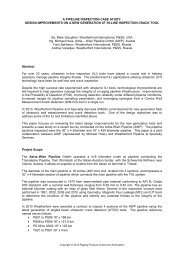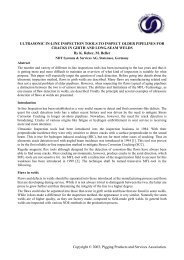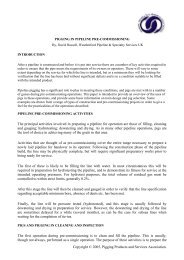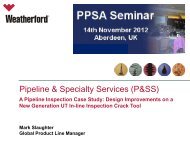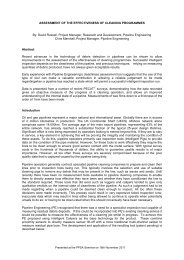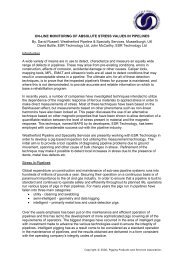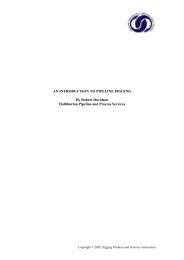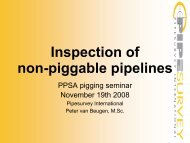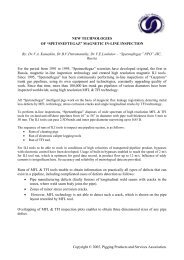safe pigging operation - PPSA, the Pigging Products and Services ...
safe pigging operation - PPSA, the Pigging Products and Services ...
safe pigging operation - PPSA, the Pigging Products and Services ...
You also want an ePaper? Increase the reach of your titles
YUMPU automatically turns print PDFs into web optimized ePapers that Google loves.
H2S involvement<br />
In a H2S environment <strong>the</strong>re is often a vent connected to a header <strong>and</strong> a drain connected to a close<br />
drain system. This means <strong>the</strong> drain <strong>and</strong> vent must still be opened to drain <strong>and</strong> depressurize but also<br />
closed again before opening <strong>the</strong> closure. Next to that <strong>the</strong> vessel must also be purged several times in<br />
combination with <strong>the</strong> vent to reduce <strong>the</strong> level of H2S to guarantee <strong>safe</strong> opening of <strong>the</strong> closure.<br />
With <strong>the</strong> principle of key transfer a “linear sequence“ can be guaranteed, 1 step at a time but to<br />
guarantee opening <strong>and</strong> closing of a valve <strong>and</strong> multiple opening of a valve as for example during<br />
purging, a mechanical control box is available to guarantee also “non linear sequences”. After each<br />
<strong>operation</strong> <strong>the</strong> key is returned to this control box confirming <strong>the</strong> step <strong>and</strong> releasing a new key, this step<br />
could be <strong>the</strong> same step repeatedly as programmed.<br />
It checks every step <strong>and</strong> guides <strong>the</strong> operator through a complicated sequence where launching,<br />
receiving, flushing, etc… is controlled <strong>and</strong> valves are opened <strong>and</strong> closed repeatedly in a non linear<br />
sequence.<br />
Continuous production<br />
The throttle is parallel to <strong>the</strong> vessel <strong>and</strong> by closing it slowly <strong>the</strong> process is diverted through <strong>the</strong> vessel<br />
to launch <strong>the</strong> pig. As mentioned as a potential risk it is important to open <strong>the</strong> throttle again before<br />
isolating <strong>the</strong> vessel (closing <strong>the</strong> bypass) to guarantee continuous production. So optionally a key<br />
interlock is installed on <strong>the</strong> Throttle also <strong>and</strong> it can only be closed after <strong>the</strong> kicker <strong>and</strong> main valves are<br />
open. To release <strong>the</strong> key to close <strong>the</strong> kicker <strong>and</strong> main valves <strong>the</strong> throttle must be fully opened first.<br />
Conclusion<br />
Operating a pig launcher / receiver is a high risk event with people involved <strong>and</strong> at <strong>the</strong> same time <strong>safe</strong><br />
<strong>operation</strong> depends on <strong>the</strong>se people. Mechanical interlocks take out <strong>the</strong> human factor of possible<br />
mistakes <strong>and</strong> guide <strong>the</strong> operator through a <strong>safe</strong> pre-determined sequence.<br />
Several international companies recognized <strong>the</strong> potential danger <strong>and</strong> included or highly recommend<br />
interlocks in <strong>the</strong>ir design specifications.<br />
• Shell U.K. Exploration <strong>and</strong> Production<br />
Engineering Reference Document. Design of Pig Launcher & Receiver<br />
EA/061 Rev.1 (1994)<br />
Addendum to DEP 31.40.10.13 – GEN (Design of a Pig Trap System)<br />
Systems – Doc. No.<br />
• ADCO - Abu Dhabi Company for Onshore Oil Operations.<br />
Guidelines for preparation of a project health, <strong>safe</strong>ty <strong>and</strong> environmental (HSE) philosophy<br />
document (ADCO Doc. No. 30.99.91.003 : Nov. 2005).<br />
• BP - British Petroleum<br />
Guidance on Practice for <strong>Pigging</strong>, Pig Launchers, <strong>and</strong> Receivers.<br />
(Document No. GP 43 – 50 : 27 th April 2006).<br />
Presented at <strong>the</strong> <strong>PPSA</strong> Seminar on 17th November 2010



